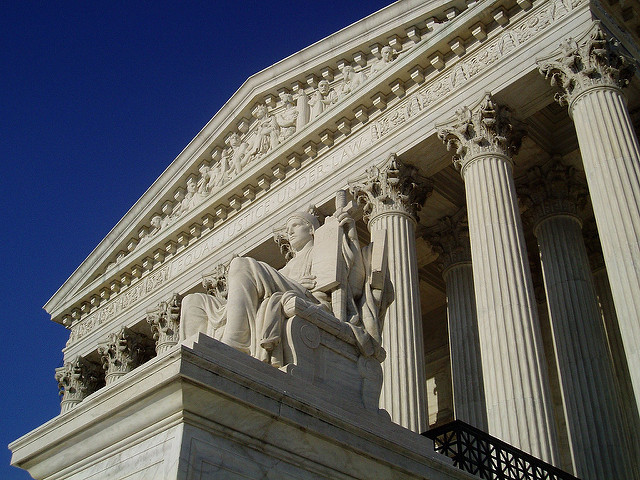
On Friday, the Department of Health and Human Services withdrew anti-discrimination provisions for LGBTQ patients. Three days later, a landmark Supreme Court decision called the policy change into question.
“It’s a bit of a whiplash. Friday sent a strong message from one branch of government and today sent the opposite message from another branch of government,” said Jennifer Kates, senior vice president and director of global HIV policy for the Kaiser Family Foundation. “Certainly, the decision (on Monday) changes the calculus from Friday completely.”

Transforming Clinical Content with Ambient & Generative AI
Sheila Bond, MD, talked about the latest trends regarding integration of AI in healthcare.
The 6-3 Supreme Court decision cemented LGBTQ workers’ protections under Title VII of the Civil Rights Act, which prohibits discrimination on the basis of race, sex, religion or national origin. The landmark decision in Bostock v. Clayton County ruled that those protections include sexual orientation and gender identity.
“In Title VII, Congress adopted broad language making it illegal for an employer to rely on an employee’s sex when deciding to fire that employee. We do not hesitate to recognize today a necessary consequence of that legislative choice: An employer who fires an individual merely for being gay or transgender defies the law,” the Supreme Court stated in its opinion.
While the decision applies to a different part of the law than HHS’ final rule, it could still have implications further down the line.
“There’s a big question right now about whether that rule is going to be able to go forward,” Kates said. “It would certainly face a lot of challenges in court.”
HHS narrows protections
HHS’ Office of Civil Rights is expected to publish the final rule in the Federal Register on Friday. The agency could potentially withdraw portions of it in response to the Supreme Court ruling.
The final rule would diminish the Affordable Care Act’s anti-discrimination provisions, defining discrimination on the basis of sex solely to mean male or female.
Under Section 1557 of the Affordable Care Act, healthcare providers are required to treat individuals consistent with their gender identity, and insurers are prohibited from imposing transgender-specific exclusions to care. Under the final rule, HHS’ Office of Civil Rights would no longer enforce these protections.
Not only could it affect care specific to an individual’s gender identity, but it could affect discrimination related to other health needs. For example, an insurer could deny coverage for transition-related care or mental health care, Kates said, or a transgender man could be denied treatment for ovarian cancer, or a hysterectomy.
“That is a risk here if this were to go forward unchallenged,” she said.
The American Medical Association wrote a scathing rebuttal of the rule after the initial draft was released last year.
“It legitimizes unequal treatment of patients by not only providers, health care organizations, and insurers, but also by the government itself — and it will harm patients,” AMA CEO Dr. James Madara wrote in a letter to HHS Secretary Alex Azar. “It deems certain classes of people less worthy of care, compassion, access, and good health than others. Such policy should not be permitted by the U.S. government, let alone proposed by it.”
Insurance groups, including America’s Health Insurance Plan and the Blue Cross Blue Shield Association, also spoke out in disagreement with HHS’ decision.
The final rule also narrows where the ACA’s broader anti-discrimination provisions would apply. It would limit them to healthcare providers, and only health plans that receive federal financial assistance, such as ACA marketplace plans or Medicare Advantage plans.
HHS claims the changes will save insurers $2.9 billion over five years by not having to send “notice and tagline” inserts in healthcare mailings. But it also ignored submitted comments about the “potentially billions in costs” associated with the denial or delay of healthcare to LGBTQ people because of discrimination, Katie Keith, an attorney and researcher for Georgetown University’s Center on Health Insurance Reforms, wrote in HealthAffairs.
What it means for health plans
The Supreme Court decision would strengthen future legal challenges to HHS’ final rule, presenting up “uphill battle” for the agency if it continues to go forward with the changes, Keith wrote.
“Title VII and Title IX are structured in the same manner, the courts have long looked between the two statutes, and the Court’s decision made clear that being gay or transgender is “inextricably bound up with sex,” Keith wrote. “One would think that such a resounding Supreme Court decision would end the dispute, but that has almost never been the case with ACA litigation.”
Currently, 23 states specifically prohibit transgender exclusions in health insurance. Despite these protections, transgender patients have faced obstacles in accessing care. In a 2018 survey, a quarter of respondents said they had experienced a problem with their insurance in the past year related to being transgender.
There have been some improvements in the past four years. A growing number of marketplace plans have incorporated language saying they would cover some or all needed treatment for gender dysphoria. That number was 47% in 2020, according to Out2Enroll, an initiative to connect members of the LGBTQ community with health insurance. And the vast majority of insurers — 97% — did not include transgender-specific exclusions in their 2020 silver marketplace plans.
As for how employers and health plans will interpret the final rule, it’s difficult to say.
“It’s a little hard to know. I think we will see this unfolding over several months. Some plans may make changes based on the regulation. There will likely be litigation over it,” said Abigail Coursolle, a senior attorney with the National Health Law Program. “Some of these (rule changes) could lead to more subtle changes in how healthcare is delivered.”
But employers will also look to the Supreme Court decision as they make choices about health insurance benefits. The ruling might give them the impetus to ensure their health plans don’t have transgender health coverage exclusions.
“It is reasonable to assume this extends to benefits like health insurance and that those benefits must be offered equally to LGBT people. Similarly, the Court’s ruling should put insurers on notice that federal sex nondiscrimination protections, such as Title IX and thus Section 1557 of the ACA, extend to LGBT people,” Keith wrote in an email. “Fortunately, many insurers and employers have stopped using these discriminatory practices, but I expect that the ones that still do will be taking a look at their benefits offerings and making changes as needed.”
Most companies, but not all, extend health insurance benefits to same-sex spouses. The Supreme Court ruling could spur the remainder into action.
Photo credit: Matt Wade, Flickr








